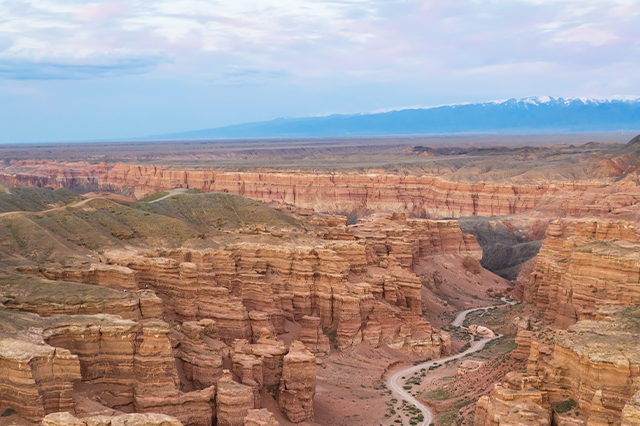Nestled within the vast expanse of Kazakhstan, Tarbagatai National Park stands as a testament to the country's commitment to preserving its natural wonders. Established in 2018 in the Urjar district of the Abay region, this national park unfolds as a captivating mosaic of climatic zones, offering an immersive journey into untamed beauty.
Tarbagatai National Park is more than a scenic destination; it's a conservation effort dedicated to safeguarding the natural systems of the southern slope of the Tarbagatai Range, as well as the Karabas and Arkaly mountains, and the valleys of the Urzhar, Katynsu, and Emel rivers. The park's diverse climatic belts are crucial to its ecological richness.
On the southern slope, the steppe belt sprawls across shallow-flat and gently sloping foothills, reaching its pinnacle in the eastern part at 1000-1200 meters above sea level. Here, resilient plant life adapted to semi-arid conditions paints a vivid tapestry of colors and textures, showcasing the steppe's ability to thrive.
Dominating the steep southern slope of the main ridge, the shrub belt spans altitudes from 700-1200 to 1700-1800 meters a.s.l as it descends to gently sloping loess foothills in its central part, a diverse array of shrub species, resilient to higher elevations, flourishes in this harsher environment.
Occupying the southern slope from 1700-1800 to 2400 meters above sea level, the subalpine belt unfolds across gentle slopes and plateau-like leveled watersheds. Characterized by rock outcrops and stony slopes, this belt is a testament to flora's adaptability to the challenging subalpine terrain.
The highest realm, the alpine belt, ranges from 2400-3100 meters asl, primarily occupying the watershed part of the ridge. Though mostly leveled, it features stony wastelands, steep slopes, screes, and small pond lakes—a breathtaking domain where resilient plant life and captivating scenery converge at high altitudes.
Within the park's boundaries lies a rich tapestry of flora and fauna, contributing to its ecological significance. Boasting 167 endemic species, including notable varieties like Mertensia tarbagataica, Popovii, Stelleropsis tarbagataica, and Acantholimon tarbagataicum, the park emerges as a haven for botanical diversity. Notably, 32 species of higher vascular plants find sanctuary here, listed in the Republic of Kazakhstan's catalog of rare and endangered species.
The avian residents of Tarbagatai National Park include 33 bird species, with 17 of them calling the park home for breeding. These birds contribute to the park's vibrant ecosystem, from the revered black stork and snake-eater to the steppe and golden eagle. Notably, the Huma, attributed to the bearded vulture, holds a mythical and sacred connection in Persian culture, mirroring its presence on the state emblem of Uzbekistan.
Venturing into the realm of rare mammals, the park hosts elusive creatures such as the Tien Shan bear, stone marten, manul, Turkestan lynx, snow leopard, and Kazakh argali. The sighting of a banded lynx, resembling a prairie ferret with spots reminiscent of predatory cats, adds a touch of mystery to the sandy massifs along the Emeli valley. Additionally, the striped stripe, the rarest snake in Kazakhstan, further emphasizes the park's ecological significance.
Preparing for Your Journey:
Before embarking on your journey, exploring valuable insights and practical information about Tarbagatai National Park is highly advisable. A visit to their official website at www.tarbagatay-gnpp.kz will equip you with essential details about available tours and comprehensive amenities. For instance, parking costs 136 tenge per day, and the website provides intricate information to enhance your trip planning.
The website offers a unique opportunity to explore Tarbagatai National Park through an immersive 3D tour virtually. Given the park's expansive size, most excursions are a harmonious blend of walking and automobile rides, often spanning an entire day and covering over 100 kilometers. It is crucial to note that these tours are predominantly operational from June to October, subject to weather conditions. Due to the unpredictable nature of weather patterns, tour cancellations may occur, ensuring visitor safety and comfort.
It is imperative to plan your visit diligently, considering that only a limited number of visitors, ranging from 20 to 50 people per month, are permitted. This restriction enhances the exclusive and intimate experience for each visitor and aligns with the park's commitment to environmental conservation. As you prepare for your journey, the insights from the website will prove invaluable. From tour specifics to on-site amenities and potential weather-related contingencies, this preparatory phase ensures that your exploration of Tarbagatai National Park is memorable and undertaken with a comprehensive understanding of what awaits.
Selecting the optimal time for your visit is crucial. Research the park's seasonal accessibility, ensuring it aligns with your travel plans. Tarbagatai National Park, while not open year-round, offers a unique opportunity during the summer. Though this season is typically the peak for national parks across Kazakhstan, the newly opened Tarbagatai remains uncrowded, providing an unparalleled chance for solitude and connection with the untamed wilderness.
Proper gear is essential for a seamless and enjoyable journey. A well-equipped daypack containing essentials such as sunscreen, a hat, water bottle, snacks, and sunglasses is vital for day trips within the park. Given the wilder nature of Tarbagatai National Park, packing a picnic is advisable to ensure sustenance during your explorations. Opting for a backpack over a suitcase enhances mobility, and carrying an ample water supply is imperative for staying hydrated during extended hikes.
Planning is the key to avoiding disappointments caused by crowded campsites and a lack of lodging options. While some popular national parks draw massive crowds, Tarbagatai's pristine and unspoiled nature remains a hidden gem. Booking ahead ensures a quiet haven free from the distractions of loud music and bustling crowds, providing an authentic connection with the park's natural wonders.
Given the expansive nature of Kazakhstan's national parks, a thoughtful approach to time management is essential. Tarbagatai National Park, with its vast territory, requires visitors to prioritize destinations based on personal preferences and interests. Rather than attempting to cover every sight in a single trip, focus on a select few and savor the experience. Leaving room for future visits ensures a deeper exploration of the park's diverse landscapes.
While camping offers an immersive experience, alternating with a night at a lodge provides a balanced perspective. Camping allows for a direct connection with the wilderness, while a lodge offers comfort and a chance to witness the park's nocturnal beauty. Striking this balance ensures a comprehensive experience, embracing the rugged and refined aspects of Tarbagatai National Park.
The park rangers, clad in their distinctive uniforms, are invaluable allies for visitors. Beyond ensuring safety, rangers possess in-depth knowledge of the park's terrain. Upon arrival, building a rapport with them can result in insider information, including prime spots, safety tips, shortcuts, and recommendations for the best places to enjoy a picnic or witness a stunning sunset. The expertise of these guardians enhances the overall journey, providing a deeper understanding of the park's nuances.
As you traverse Tarbagatai National Park, you transcend the role of a mere spectator. You become a custodian of its pristine grandeur, preserving its delicate balance with its diverse climatic zones, unique flora, and rare fauna. The "leave no trace" ethos takes on heightened significance, urging visitors to depart without a footprint and contribute to conserving these natural wonders.
In preserving this wilderness, we collectively ensure its legacy for future generations—a testament to the delicate symbiosis between humanity and the natural world. Tarbagatai National Park beckons as an untouched canvas for your wilderness odyssey, where every step is a commitment to respecting and cherishing the untamed beauty that unfolds at every turn.




















